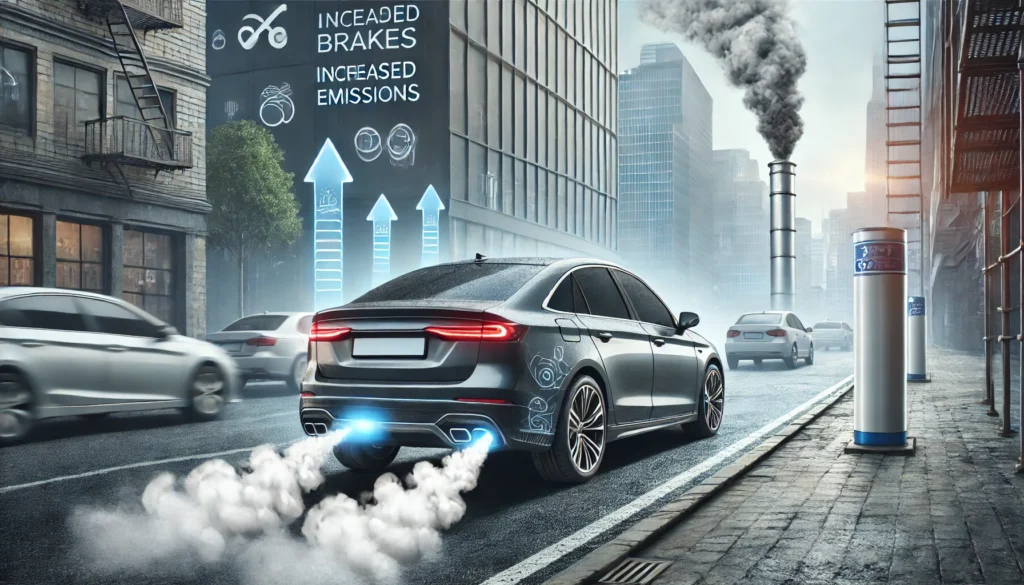The Anti-lock Braking System (ABS) and brake systems are critical components of modern vehicles, designed to ensure safety and control during driving. When faults occur in these systems, indicated by the ABS or brake lights on the dashboard, the primary concern is usually safety. However, these faults can also have significant environmental impacts. Understanding these impacts can help highlight the importance of maintaining these systems not only for safety but also for environmental sustainability.
Environmental Impacts of ABS and Brake Light Faults
- Increased Emissions:
- Effect: Faulty ABS and brake systems can lead to inefficient driving, requiring more frequent and harder braking. This can cause the engine to work harder and burn more fuel.
- Impact: Increased fuel consumption directly results in higher emissions of greenhouse gases such as carbon dioxide (CO2) and pollutants like nitrogen oxides (NOx) and particulate matter.
- Scenario: A vehicle with a malfunctioning ABS might require the driver to brake more cautiously and more often, leading to higher fuel consumption and greater emissions over time.
- Brake Pad and Rotor Wear:
- Effect: Faulty brakes can cause uneven or excessive wear on brake pads and rotors.
- Impact: The wear and tear produce brake dust, which contains heavy metals and other pollutants that can contaminate air and water.
- Scenario: Worn-out brake pads due to a brake system fault can increase the amount of brake dust released into the environment, contributing to air pollution and harming aquatic ecosystems when washed away by rain.

- Resource Depletion:
- Effect: Frequent replacements of brake components due to faults can lead to increased resource consumption.
- Impact: Manufacturing new brake components requires raw materials and energy, contributing to resource depletion and environmental degradation.
- Scenario: If brake pads and rotors need to be replaced more frequently due to ABS or brake light faults, the demand for materials like steel, copper, and rubber increases, leading to higher environmental costs from mining and manufacturing processes.
- Increased Tire Wear:
- Effect: Faulty ABS can cause uneven tire wear, as the system may not properly modulate braking pressure.
- Impact: Increased tire wear leads to more frequent tire replacements, contributing to landfill waste and environmental pollution from tire production processes.
- Scenario: A vehicle with a malfunctioning ABS might cause tires to wear out faster, resulting in the disposal of more tires and greater environmental impact from tire manufacturing.

Preventive Measures
- Regular Maintenance:
- Action: Regularly check and maintain the ABS and brake systems to ensure they are functioning correctly.
- Benefit: Proper maintenance can prevent faults, reducing the environmental impact associated with increased emissions, wear, and resource consumption.
- Prompt Repairs:
- Action: Address ABS and brake light faults immediately by diagnosing and repairing the issues.
- Benefit: Prompt repairs can prevent further damage to the vehicle and the environment by maintaining efficient braking and reducing unnecessary wear and emissions.
- Eco-friendly Products:
- Action: Use environmentally friendly brake pads and components that produce less dust and are made from sustainable materials.
- Benefit: Reducing the environmental impact of brake wear and supporting sustainable manufacturing practices.
Conclusion
ABS and brake light faults not only compromise vehicle safety but also have significant environmental impacts. Increased emissions, brake dust pollution, resource depletion, and tire wear are all consequences of neglected brake system maintenance. Regular maintenance and prompt repairs are crucial to minimize these environmental impacts, ensuring that your vehicle remains both safe and eco-friendly.